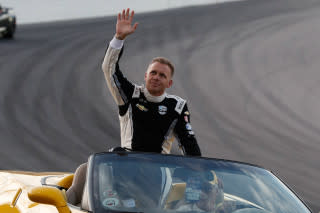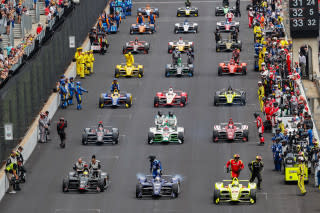Did the Matriarch of the George Family of the Indy 500 Die
Information technology has been seven weeks since the transfer of buying of IndyCar and the Indianapolis Motor Speedway was completed on Jan. six.
During that cursory time, new possessor Roger Penske has made an immediate touch on. He has transformed the direction of the NTT IndyCar Series and announced grand plans to plow the venerable motorsports shrine into a modern-day entertainment palace.
Under Penske'southward direction, the newly formed Penske Entertainment is moving full speed ahead into the future with oversight and ownership of IndyCar, the Indianapolis 500 and Indianapolis Motor Speedway.
Meanwhile, many Hulman-George family members quietly have moved on and faded from public view — just secure in the noesis that the public trust they guided for well-nigh iii quarters of a century still remains in very expert hands.
"I don't remember anyone had a better feeling or better idea of who could exist a improve successor to the Hulman-George family than Roger Penske," Ed Carpenter, a Hulman-George family fellow member and shareholder in Hulman & Company, told NBCSports.com recently. "He gets it. He is going to do a bully job. His concern enterprise is and so huge. It makes us all excited to run into what he is going to exercise what is at that place already.
"It's different for everybody in the family. It has been an emotional process and transition. I think one affair everyone tin agree on is it'due south going to be exciting to see the adjacent 100 years."
For more than 74 years, Indianapolis Motor Speedway and the Indy 500 were run under their stewardship. It began with Tony Hulman of Terre Haute, Indiana, buying the decaying facility from previous possessor Eddie Rickenbacker on Nov. 14, 1945 for $750,000.
In announcing the sale of IMS and IndyCar final November, sometime track chairman Tony George said the family unit had taken IndyCar and the speedway as far as information technology could. Information technology was time for a new leader in Penske, who is the most successful squad owner in auto racing history with a record 18 Indianapolis 500 victories and 16 IndyCar series championships.
Carpenter continues in the NTT IndyCar Series as an possessor-commuter. His mother, Laura, has been married to Tony George since he was a youngster. Carpenter knew well-nigh the sale before any other drivers in the series and too was enlightened of other bidders.
"My reaction was much unlike when Roger became function of the chat instead of some of the other conversations that were had," Carpenter said. "It made me experience a whole lot better."

Carpenter believes his family will exist just fine away from the public spotlight.
"The bad times are a decade quondam," Carpenter said. "They weathered the storm a long time ago. They take been focusing on other things and other businesses and traveling and family unit."
Penske continues to continue Tony George in the loop when it comes to changes he is making to Indianapolis Motor Speedway. Some may view it every bit a professional person courtesy, merely Penske understands and respects what the Hulman-George family has meant for the sport. Penske even has talked about naming George to the new company's board of directors.
George is the sole North American benefactor of SONAX, a line of automotive refinishing products and polishes. He also is involved with Ed Carpenter Racing. George's sisters, nephews and nieces all accept moved on since the sale was completed.
"As far equally Tony goes, I haven't noticed a huge change because he is who he is," Carpenter said. "I think he is at peace with everything. As his son, I haven't noticed a huge departure. He is more relaxed now."
George can breathe easier because it'due south a happy catastrophe for the crown gem of a family unit business concern that began a century ago.
The Hulman fortune came from a variety of businesses, including Clabber Girl Baking Powder. Financially, Hulman turned that $750,000 buy price into an firsthand profit when he sold the concession rights to Sports Service for $ane 1000000 over 10 years.
The Indianapolis 500 had been halted from 1942-45 because of Earth War II. Hulman revived the Memorial Day weekend classic in 1946 and during his helm, built it into the largest single-twenty-four hours sporting event in the world with crowds in excess of 300,000 spectators.
The Indianapolis 500 besides put the city on the map. Today, Indianapolis is a professional sports metropolis with the NFL'due south Indianapolis Colts, the NBA'south Indiana Pacers and the WNBA's Indiana Fever. Information technology's probable none of that would have been possible if the sporting spotlight did not shine on the majuscule urban center of Indiana every Memorial Day weekend, bringing the world to the "Crossroads of America."
Hulman died Oct. 27, 1977 at the age of 76. His widow, Mary Fendrich Hulman was in accuse of the family unit business with the Speedway capably run by the likes of John Cooper and Joe Cloutier. As Mrs. Hulman aged, the couple's simply child, Mari, took over as the family unit dame.
Previously married to the late Elmer George, a race driver, Mari Hulman George had three daughters and a son, Tony. He eventually would become president of Indianapolis Motor Speedway in 1989 afterwards Cloutier died.
It was under Tony George'southward leadership that Indianapolis Motor Speedway entered an aggressive period of change. He brought NASCAR to the "hallowed grounds" for a tire test in 1992, breaking with tradition of Indy cars only at IMS. That led to the inaugural Brickyard 400 on Aug. six, 1994.
It was probably the most anticipated race in car racing history at that fourth dimension considering of what information technology meant. The Indianapolis 500 had been run since 1911 and from that appointment forward, with the exception of Earth War I and World War 2, it was the home of Indy car racing. The beginning Brickyard 400 helped serve as a launching pad to NASCAR's incredible growth from the mid-1990s through the next 15 years before it began to fade.
George also took the huge gamble and risk of breaking away from the team owner-driven Championship Machine Racing Teams excursion and creating the Indy Racing League. He appear the new series in 1994, and it began competition in 1996.
CART teams viewed information technology as a hostile takeover and boycotted the Indianapolis 500 beginning in 1996. The top teams stayed unified in that cold-shoulder until team owner Chip Ganassi entered two cars in the 2000 Indianapolis 500 with so-defending CART champion Juan Montoya and Jimmy Vasser equally the drivers.

The race was no contest. Montoya whipped the field, leading 167 of the 200 laps and became the kickoff rookie since Graham Hill in 1966 to win the Indy 500. Team Penske joined Ganassi in 2001 and another rookie, Helio Castroneves, won for Penske.
That created a shift that ultimately spelled doom for CART and its successor, Champ Car. With the big teams returning to the Indy 500 and joining the Indy Racing League, it was simply a thing of fourth dimension before one series would survive and the other would become extinct.
George negotiated a unification plan with Champ Car Series dominate Kevin Kalkhoven in early 2008, bringing Champ Machine'south teams to the IRL. George would provide them with free cars and equipment to help in the transition.
Beginning in 2008, IndyCar racing was whole, again.
One twelvemonth later, George's sisters who were also owners of IMS and IndyCar believed the family fortune had been spent. They ousted Tony from his position in a lath meeting ii days after Castroneves won his 3rd Indy 500 in 2009. George left the company completely only would return a few years later.
IndyCar continued with some fantastic racing during the ensuing years, merely it relatively went unnoticed by the residue of the sporting world. Randy Bernard tried to bring some attention to the series as its new promoter, simply many of his ideas missed the mark completely, and his management fashion led to his ouster in October 2012.

Marking Miles was tapped with the duty to bring IndyCar and the Indianapolis Motor Speedway back to relevance. He promoted Doug Boles to president of IMS and hired Jay Frye equally chief marketing officeholder and promoting him to IndyCar president in 2015.
They began the long climb back to prominence. Tony George returned as IMS chairman of the board equally Mari Hulman George entered the final years of her life.
She died on Nov. three, 2018.
On Nov. iv, 2019, the Hulman-George family unit appear the sale of IndyCar, Indianapolis Motor Speedway and IMS Productions to Roger Penske.
It was just ane twelvemonth and 1 day since Mari Hulman George had died.
Carpenter is no longer a shareholder, merely as a competitor, he remains a stakeholder in IndyCar'southward growth.
"For me, racing there with the change of ownership, it doesn't experience any different," Carpenter said. "I get asked, 'What would it hateful to win the Indy 500 with your family owning the place?' It doesn't hateful whatever more to me than anyone else.
"We all want to exist IndyCar drivers because of the Indianapolis 500. My connection to the track has always been every bit a competitor. When nosotros all get in that location, nosotros all feel like nosotros are office of it, and nosotros all ain office of it.
"That remains unchanged."
Follow Bruce Martin on Twitter at @BruceMartin_500
Source: https://sports.yahoo.com/hulman-george-family-quietly-fades-181536147.html
0 Response to "Did the Matriarch of the George Family of the Indy 500 Die"
Post a Comment